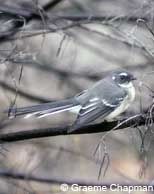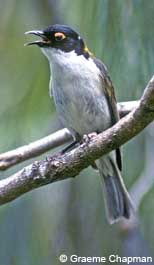Home
About Woodlands
Meet the Animals
Conservation Tips
Puzzles
Further Info
Creatures of the Woodland Canopy
Amidst the tangle of branches and leaves comprising the eucalypt canopy hide an astonishing number of animals. To avoid over-crowding, different species inhabit different parts of the canopy. For instance, White-naped Honeyeaters tend to forage deep in the leaves among the tree tops, while Grey Fantails are more commonly seen lower down and close to the canopy’s edge. Other species, such as Dollarbirds and Rainbow Bee-eaters, prefer protruding dead branches. In each instance, the location provides the ideal substrate from which the animal can most effectively forage for food. Specialist leaf-eaters, such as the Koala, also reside within the canopy spending their days feasting on eucalypt leaves.


Koala Phascolarctos cinerus
The koala is found throughout many types of woodland and forest in Queensland, NSW, Victoria and South Australia. Although the koala is still widespread, in some areas it is declining because of native vegetation clearing and traffic collisions. In contrast, on South Australia's Kangaroo Island where a population was introduced, trees are suffering dieback because of overgrazing by koalas.
Key habitat needs: Koalas eat about 500 g of eucalypt leaves per day. They prefer ribbon gum, blue gum, swamp gum, river red gum and forest red gum trees, growing on fertile soil. Good soil quality assists koalas to get as many nutrients as possible from their restricted diet.
Did you know? Koalas are inactive for up to 20 hours a day and their gum leaf diet includes toxic chemicals which have properties similar to those of cyanide!

Rainbow Bee-eater Merops ornatus
The Rainbow Bee-eater is found throughout Australia. Migrating populations travel as far south as Tasmania and in winter are found as far north as Papua New Guinea and Indonesia. Their arrival in Australian woodlands is a sure sign that spring has sprung.
Key habitat needs: Rainbow Bee-eaters feed on the insects attracted to flowering gum trees, including, as their name suggests, bees. Even though they are immune to bee stings, they still extract the bee's stinger by rubbing their prey against branch before eating it. They are usually found nesting near water.
Did you know? Rainbow Bee-eaters are thought to mate for life and they nest in a chamber at the end of a very narrow tunnel along riverbanks of flat ground with loamy soil. It digs these tunnels out with its sturdy legs. Such tunnels can be up to 1 m long!

Grey Fantail Rhipidura fuliginosa
The Grey Fantail is common and found throughout Australia. It feeds on insects, which it catches by darting out from a perch within the canopy. It is rarely still and is renowned for its aerial acrobatics whilst chasing insects. The southern and central Australian populations migrate north in winter.
Key habitat needs:
Grey Fantails use many different types of habitat including woodlands and suburban gardens.
Did you know? The average weight of a Grey Fantail is just 9 grams - that's the equivalent of about 2 sheets of A4 paper!

The Dollarbird comes to northern and eastern Australia each September to breed. In March or April they return to New Guinea and surrounding islands for the winter months. It is Australia's only representative of the 'Roller' bird family.
Key habitat needs: The Dollarbird inhabits open woodlands. It needs large, old trees with hollows for nesting. It likes perching on dead branches looking for flying insects and then launching on impressive aerial pursuits of their prey, which is usually caught 'on the wing' (in flight).
Did you know? The Dollarbird does not build a nest as such - it simply finds an appropriate hollow, cleans it out and uses it unlined.

White-naped Honeyeater Melithreptus lunatus
The White-naped Honeyeater is found in the eastern areas of Queensland and NSW, throughout Victoria , in south-east South Australia and southern Western Australia.
Key habitat needs: The White-naped Honeyeater prefers open eucalyptus forests and woodlands. It particularly favours manna gums and is often seen in suburban gardens. Its food sources are nectar, berries, sap, insects and lerp (sap-sucking bugs).
Did you know? Both the parents and older siblings help raise nestlings by feeding them.

